DODGE GRAND CARAVAN 2009 5.G Manual PDF
Manufacturer: DODGE, Model Year: 2009, Model line: GRAND CARAVAN, Model: DODGE GRAND CARAVAN 2009 5.GPages: 535, PDF Size: 18.61 MB
Page 71 of 535

The ORC contains a backup power supply system that
will deploy the airbags even if the battery loses power or
it becomes disconnected prior to deployment.Also, the ORC turns on the Airbag Warning
Light in the instrument panel for approxi-
mately four to six seconds for a self-check
when the ignition is first turned on. After the
self-check, the Airbag Warning Light will turn off. If the
ORC detects a malfunction in any part of the system, it
turns on the Airbag Warning Light, either momentarily
or continuously. A single chime will sound if the light
comes on again after initial startup.
It also includes diagnostics that will illuminate the instru-
ment cluster Airbag Warning Light if a malfunction is
noted. The diagnostics also record the nature of the
malfunction. WARNING!
Ignoring the Airbag Warning Light in your instru-
ment panel could mean you won’t have the airbags to
protect you in a collision. If the light does not come
on, stays on after you start the vehicle, or if it comes
on as you drive, have the airbag system checked right
away.
Front and Side Impact Sensors
Impact Sensors trigger airbag deployment in front and
side impacts, and aid the ORC in determining appropri-
ate response to impact events. Additional sensors in the
ORC determine the level of airbag deployment and
provide verification.THINGS TO KNOW BEFORE STARTING YOUR VEHICLE 69
2
Page 72 of 535
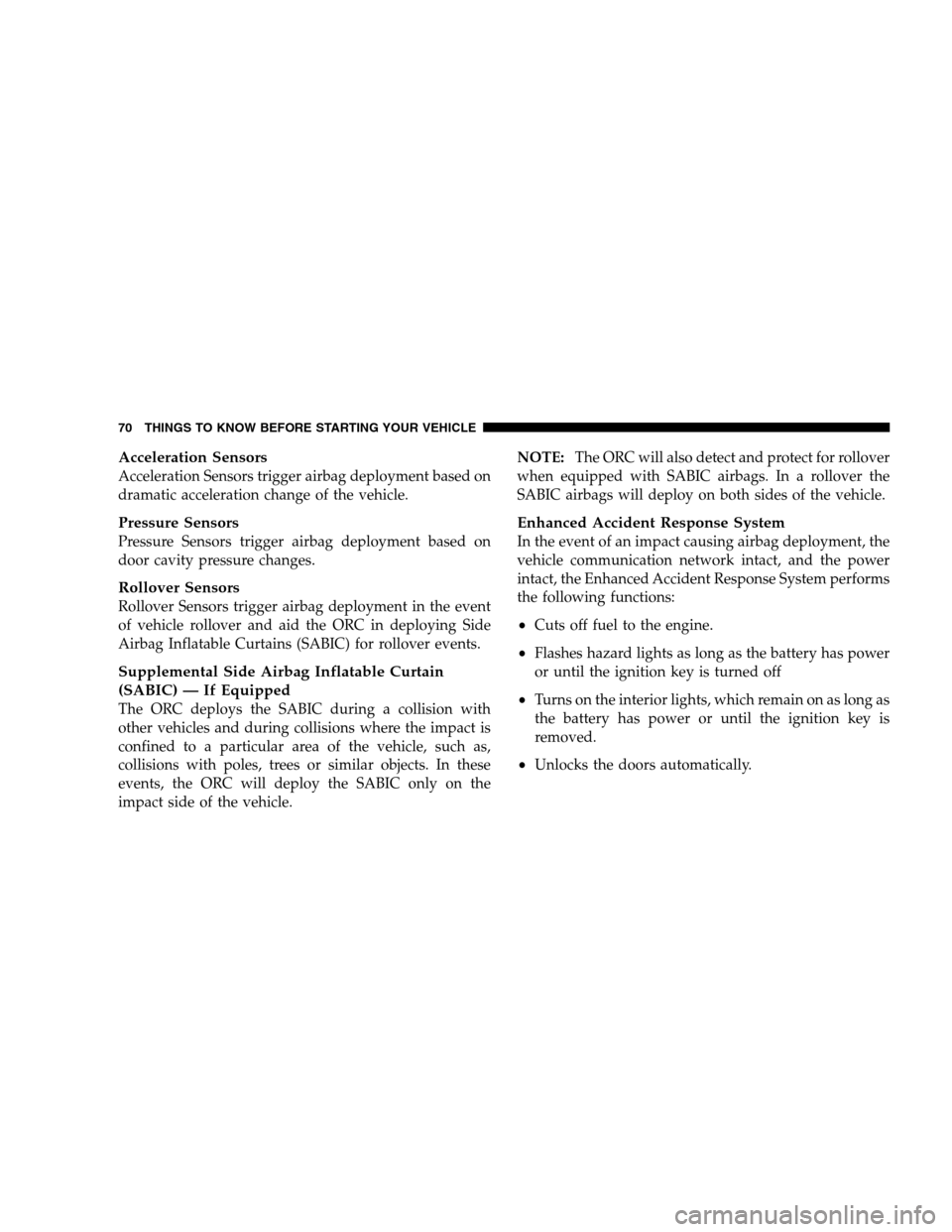
Acceleration SensorsAcceleration Sensors trigger airbag deployment based on
dramatic acceleration change of the vehicle.
Pressure Sensors
Pressure Sensors trigger airbag deployment based on
door cavity pressure changes.
Rollover Sensors
Rollover Sensors trigger airbag deployment in the event
of vehicle rollover and aid the ORC in deploying Side
Airbag Inflatable Curtains (SABIC) for rollover events.
Supplemental Side Airbag Inflatable Curtain
(SABIC) — If Equipped
The ORC deploys the SABIC during a collision with
other vehicles and during collisions where the impact is
confined to a particular area of the vehicle, such as,
collisions with poles, trees or similar objects. In these
events, the ORC will deploy the SABIC only on the
impact side of the vehicle.
NOTE:
The ORC will also detect and protect for rollover
when equipped with SABIC airbags. In a rollover the
SABIC airbags will deploy on both sides of the vehicle.
Enhanced Accident Response System
In the event of an impact causing airbag deployment, the
vehicle communication network intact, and the power
intact, the Enhanced Accident Response System performs
the following functions:
Cuts off fuel to the engine.
Flashes hazard lights as long as the battery has power
or until the ignition key is turned off
Turns on the interior lights, which remain on as long as
the battery has power or until the ignition key is
removed.
Unlocks the doors automatically.
70 THINGS TO KNOW BEFORE STARTING YOUR VEHICLE
Page 73 of 535
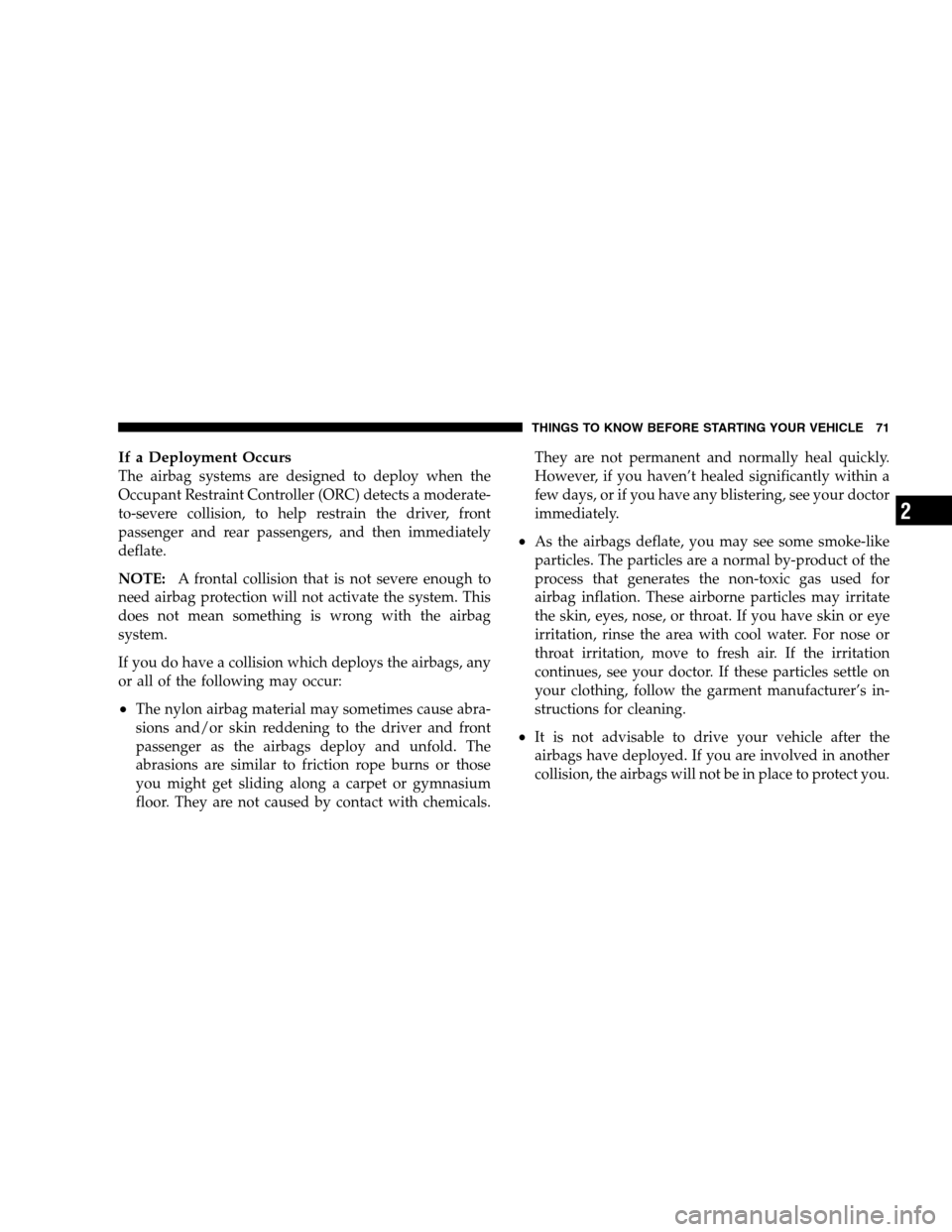
If a Deployment OccursThe airbag systems are designed to deploy when the
Occupant Restraint Controller (ORC) detects a moderate-
to-severe collision, to help restrain the driver, front
passenger and rear passengers, and then immediately
deflate.
NOTE:
A frontal collision that is not severe enough to
need airbag protection will not activate the system. This
does not mean something is wrong with the airbag
system.
If you do have a collision which deploys the airbags, any
or all of the following may occur:
The nylon airbag material may sometimes cause abra-
sions and/or skin reddening to the driver and front
passenger as the airbags deploy and unfold. The
abrasions are similar to friction rope burns or those
you might get sliding along a carpet or gymnasium
floor. They are not caused by contact with chemicals. They are not permanent and normally heal quickly.
However, if you haven’t healed significantly within a
few days, or if you have any blistering, see your doctor
immediately.
As the airbags deflate, you may see some smoke-like
particles. The particles are a normal by-product of the
process that generates the non-toxic gas used for
airbag inflation. These airborne particles may irritate
the skin, eyes, nose, or throat. If you have skin or eye
irritation, rinse the area with cool water. For nose or
throat irritation, move to fresh air. If the irritation
continues, see your doctor. If these particles settle on
your clothing, follow the garment manufacturer’s in-
structions for cleaning.
It is not advisable to drive your vehicle after the
airbags have deployed. If you are involved in another
collision, the airbags will not be in place to protect you.
THINGS TO KNOW BEFORE STARTING YOUR VEHICLE 71 2
Page 74 of 535
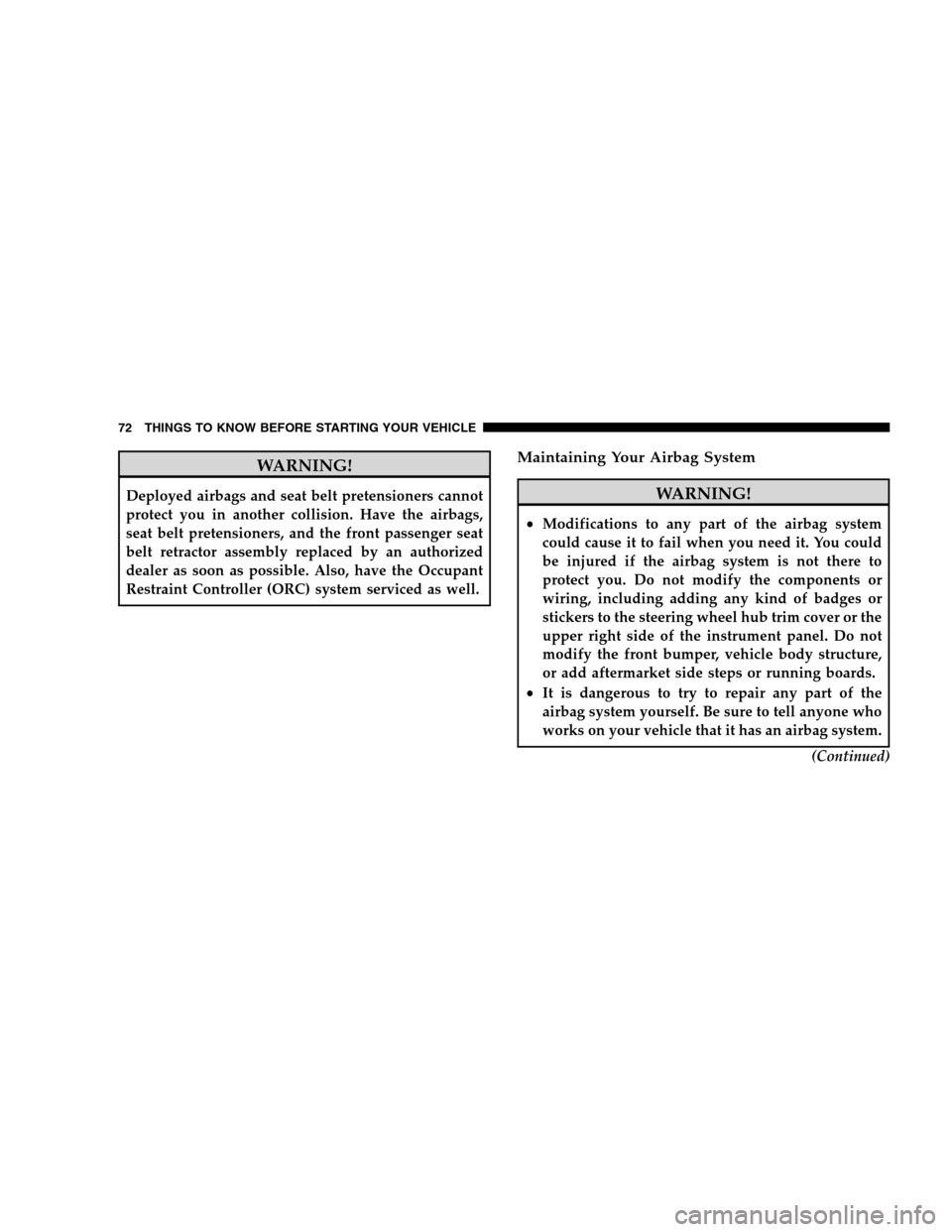
WARNING!Deployed airbags and seat belt pretensioners cannot
protect you in another collision. Have the airbags,
seat belt pretensioners, and the front passenger seat
belt retractor assembly replaced by an authorized
dealer as soon as possible. Also, have the Occupant
Restraint Controller (ORC) system serviced as well.
Maintaining Your Airbag System
WARNING!
Modifications to any part of the airbag system
could cause it to fail when you need it. You could
be injured if the airbag system is not there to
protect you. Do not modify the components or
wiring, including adding any kind of badges or
stickers to the steering wheel hub trim cover or the
upper right side of the instrument panel. Do not
modify the front bumper, vehicle body structure,
or add aftermarket side steps or running boards.
It is dangerous to try to repair any part of the
airbag system yourself. Be sure to tell anyone who
works on your vehicle that it has an airbag system. (Continued)
72 THINGS TO KNOW BEFORE STARTING YOUR VEHICLE
Page 75 of 535
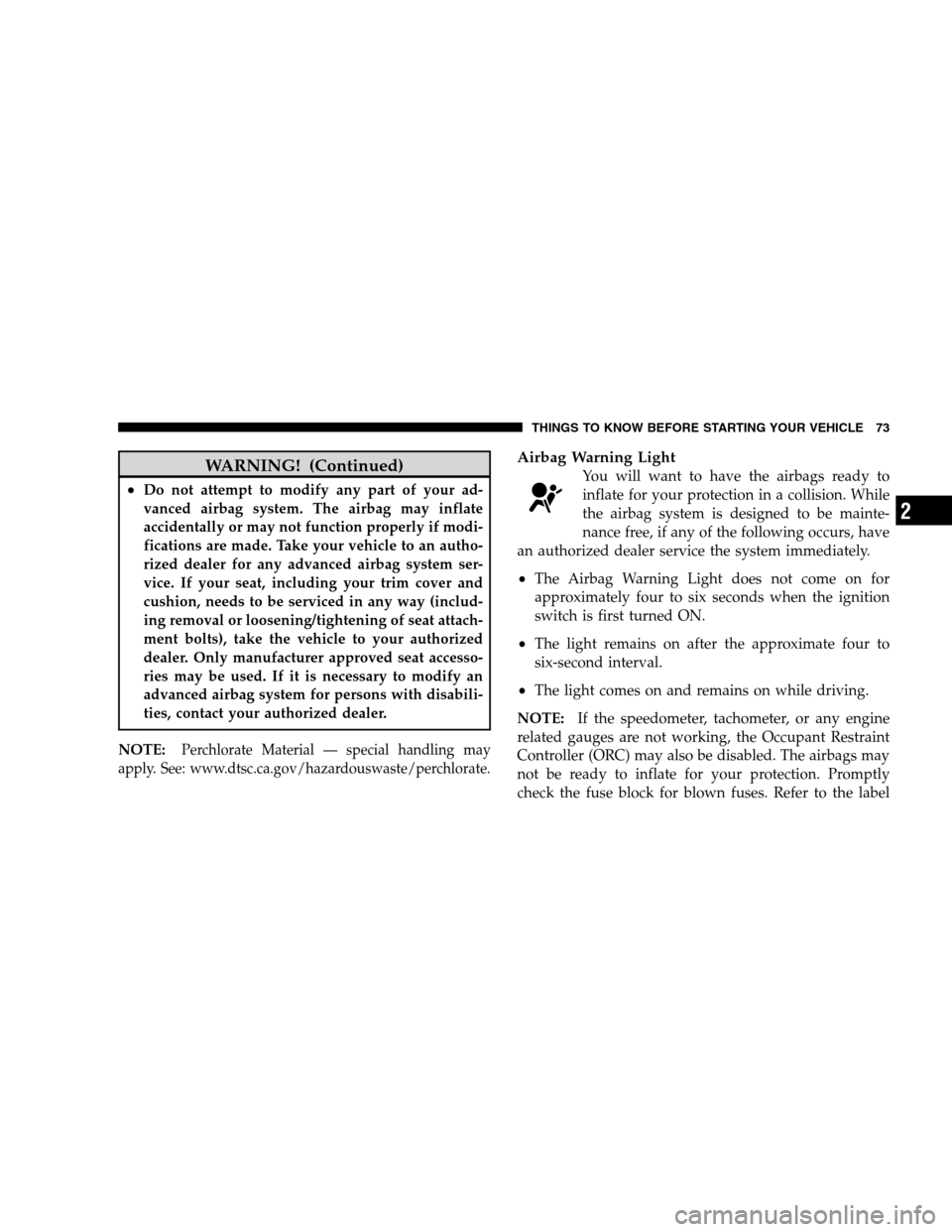
WARNING! (Continued)
Do not attempt to modify any part of your ad-
vanced airbag system. The airbag may inflate
accidentally or may not function properly if modi-
fications are made. Take your vehicle to an autho-
rized dealer for any advanced airbag system ser-
vice. If your seat, including your trim cover and
cushion, needs to be serviced in any way (includ-
ing removal or loosening/tightening of seat attach-
ment bolts), take the vehicle to your authorized
dealer. Only manufacturer approved seat accesso-
ries may be used. If it is necessary to modify an
advanced airbag system for persons with disabili-
ties, contact your authorized dealer.
NOTE:
Perchlorate Material — special handling may
apply. See: www.dtsc.ca.gov/hazardouswaste/perchlorate.
Airbag Warning Light
You will want to have the airbags ready to
inflate for your protection in a collision. While
the airbag system is designed to be mainte-
nance free, if any of the following occurs, have
an authorized dealer service the system immediately.
The Airbag Warning Light does not come on for
approximately four to six seconds when the ignition
switch is first turned ON.
The light remains on after the approximate four to
six-second interval.
The light comes on and remains on while driving.
NOTE: If the speedometer, tachometer, or any engine
related gauges are not working, the Occupant Restraint
Controller (ORC) may also be disabled. The airbags may
not be ready to inflate for your protection. Promptly
check the fuse block for blown fuses. Refer to the label THINGS TO KNOW BEFORE STARTING YOUR VEHICLE 73
2
Page 76 of 535
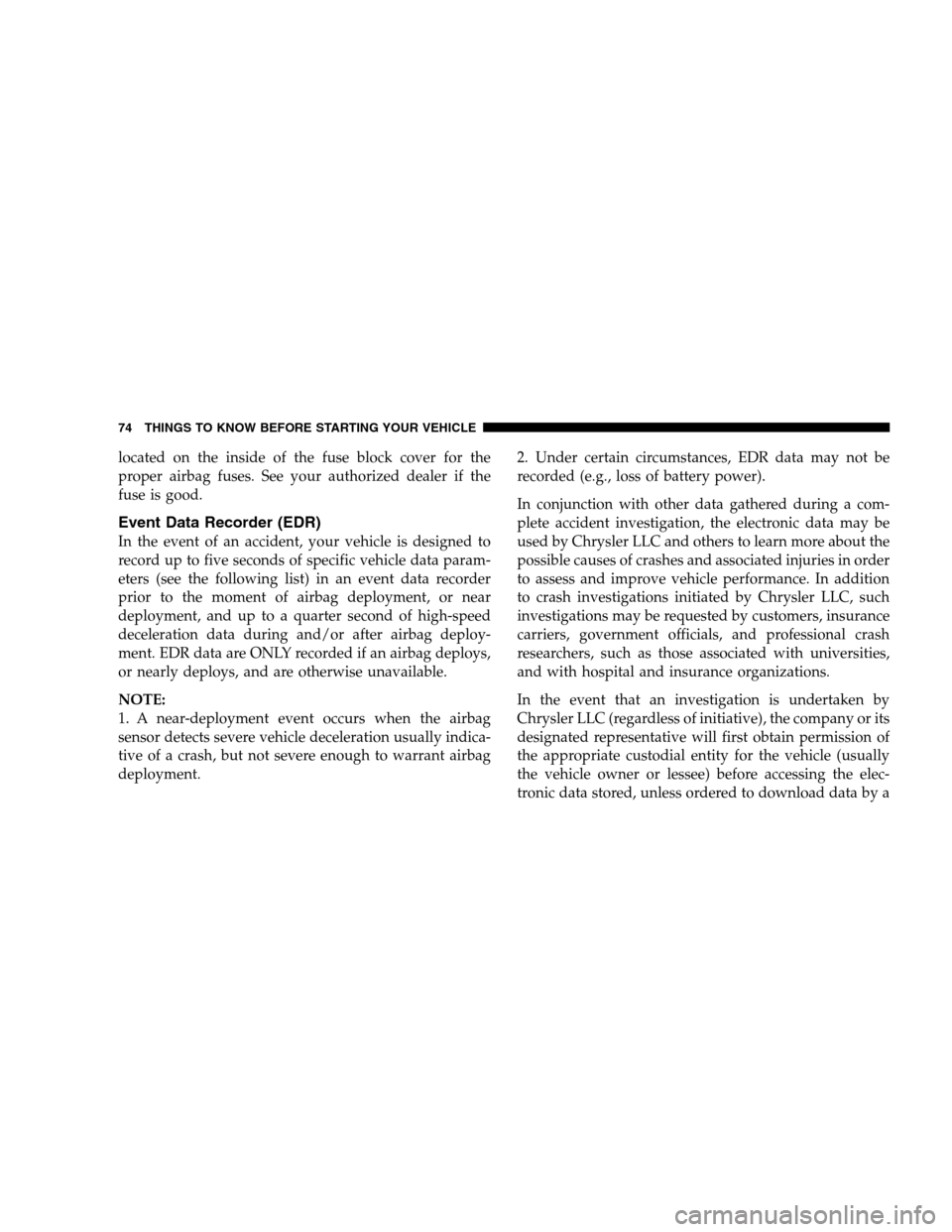
located on the inside of the fuse block cover for the
proper airbag fuses. See your authorized dealer if the
fuse is good.
Event Data Recorder (EDR)
In the event of an accident, your vehicle is designed to
record up to five seconds of specific vehicle data param-
eters (see the following list) in an event data recorder
prior to the moment of airbag deployment, or near
deployment, and up to a quarter second of high-speed
deceleration data during and/or after airbag deploy-
ment. EDR data are ONLY recorded if an airbag deploys,
or nearly deploys, and are otherwise unavailable.
NOTE:
1. A near-deployment event occurs when the airbag
sensor detects severe vehicle deceleration usually indica-
tive of a crash, but not severe enough to warrant airbag
deployment.2. Under certain circumstances, EDR data may not be
recorded (e.g., loss of battery power).
In conjunction with other data gathered during a com-
plete accident investigation, the electronic data may be
used by Chrysler LLC and others to learn more about the
possible causes of crashes and associated injuries in order
to assess and improve vehicle performance. In addition
to crash investigations initiated by Chrysler LLC, such
investigations may be requested by customers, insurance
carriers, government officials, and professional crash
researchers, such as those associated with universities,
and with hospital and insurance organizations.
In the event that an investigation is undertaken by
Chrysler LLC (regardless of initiative), the company or its
designated representative will first obtain permission of
the appropriate custodial entity for the vehicle (usually
the vehicle owner or lessee) before accessing the elec-
tronic data stored, unless ordered to download data by a
74 THINGS TO KNOW BEFORE STARTING YOUR VEHICLE
Page 77 of 535
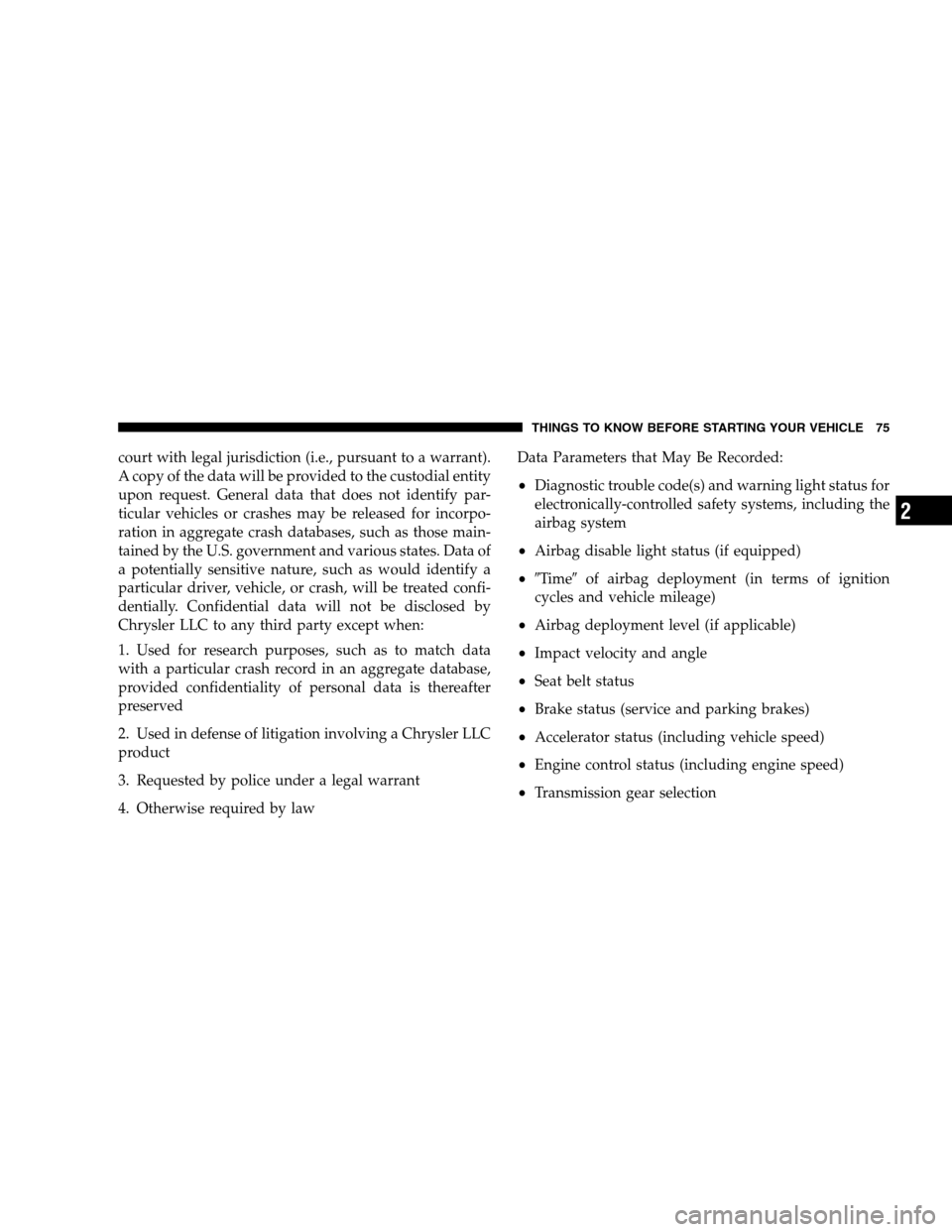
court with legal jurisdiction (i.e., pursuant to a warrant).
A copy of the data will be provided to the custodial entity
upon request. General data that does not identify par-
ticular vehicles or crashes may be released for incorpo-
ration in aggregate crash databases, such as those main-
tained by the U.S. government and various states. Data of
a potentially sensitive nature, such as would identify a
particular driver, vehicle, or crash, will be treated confi-
dentially. Confidential data will not be disclosed by
Chrysler LLC to any third party except when:
1. Used for research purposes, such as to match data
with a particular crash record in an aggregate database,
provided confidentiality of personal data is thereafter
preserved
2. Used in defense of litigation involving a Chrysler LLC
product
3. Requested by police under a legal warrant
4. Otherwise required by lawData Parameters that May Be Recorded:
Diagnostic trouble code(s) and warning light status for
electronically-controlled safety systems, including the
airbag system
Airbag disable light status (if equipped)
9Time9
of airbag deployment (in terms of ignition
cycles and vehicle mileage)
Airbag deployment level (if applicable)
Impact velocity and angle
Seat belt status
Brake status (service and parking brakes)
Accelerator status (including vehicle speed)
Engine control status (including engine speed)
Transmission gear selection
THINGS TO KNOW BEFORE STARTING YOUR VEHICLE 75 2
Page 78 of 535
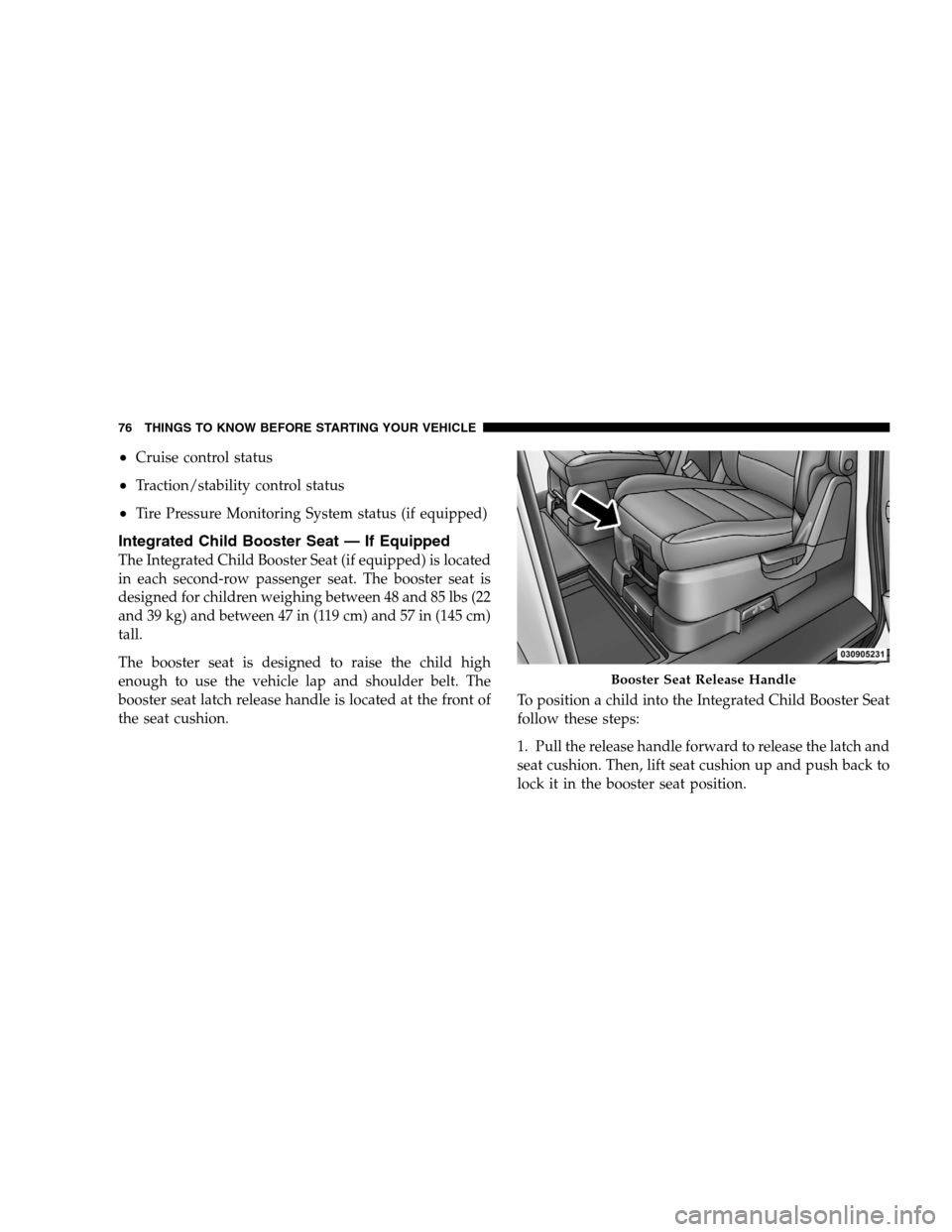
Cruise control status
Traction/stability control status
Tire Pressure Monitoring System status (if equipped)
Integrated Child Booster Seat — If Equipped
The Integrated Child Booster Seat (if equipped) is located
in each second-row passenger seat. The booster seat is
designed for children weighing between 48 and 85 lbs (22
and 39 kg) and between 47 in (119 cm) and 57 in (145 cm)
tall.
The booster seat is designed to raise the child high
enough to use the vehicle lap and shoulder belt. The
booster seat latch release handle is located at the front of
the seat cushion.
To position a child into the Integrated Child Booster Seat
follow these steps:
1. Pull the release handle forward to release the latch and
seat cushion. Then, lift seat cushion up and push back to
lock it in the booster seat position. Booster Seat Release Handle
76 THINGS
TO KNOW BEFORE STARTING YOUR VEHICLE
Page 79 of 535
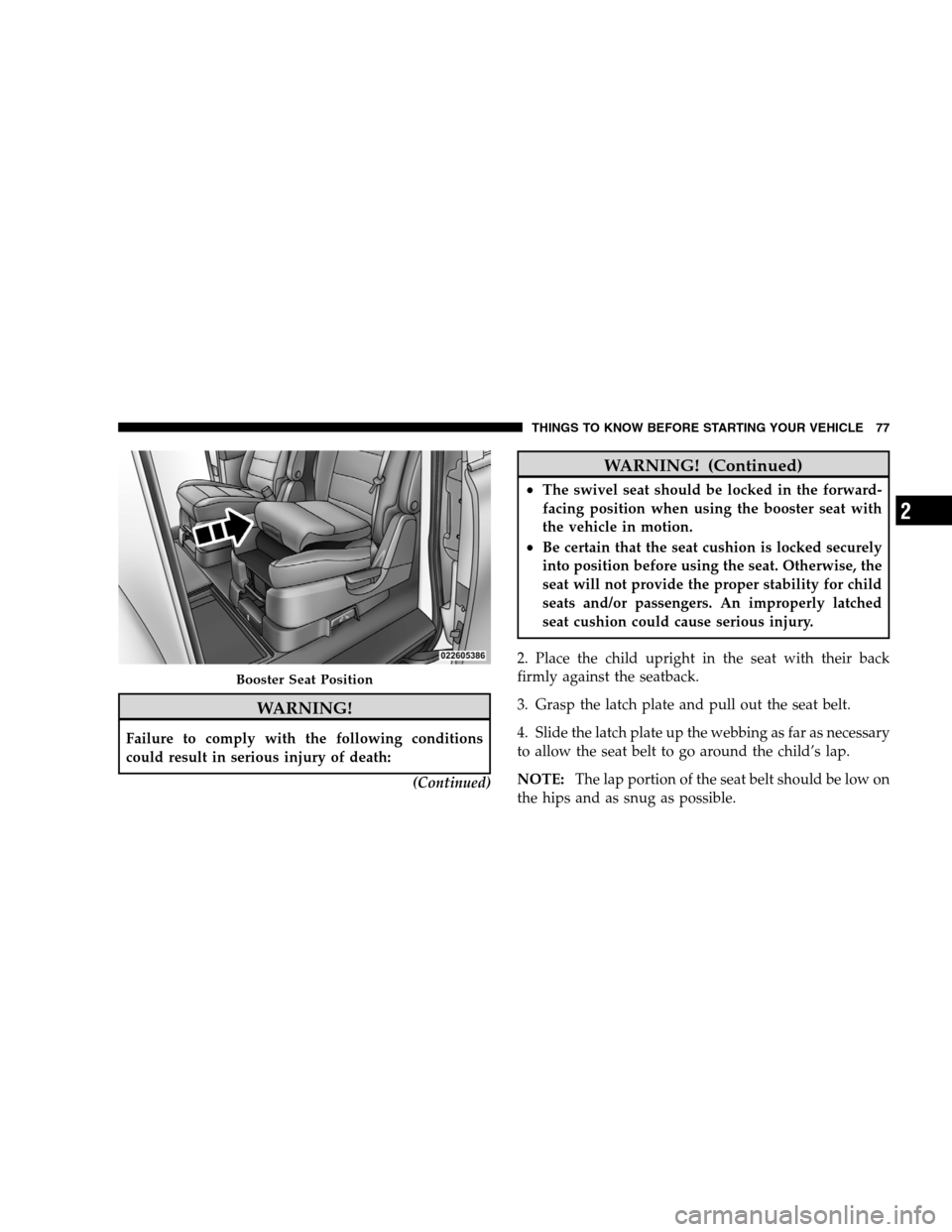
WARNING!Failure to comply with the following conditions
could result in serious injury of death:
(Continued) WARNING! (Continued)
The swivel seat should be locked in the forward-
facing position when using the booster seat with
the vehicle in motion.
Be certain that the seat cushion is locked securely
into position before using the seat. Otherwise, the
seat will not provide the proper stability for child
seats and/or passengers. An improperly latched
seat cushion could cause serious injury.
2. Place the child upright in the seat with their back
firmly against the seatback.
3. Grasp the latch plate and pull out the seat belt.
4. Slide the latch plate up the webbing as far as necessary
to allow the seat belt to go around the child’s lap.
NOTE: The lap portion of the seat belt should be low on
the hips and as snug as possible. Booster Seat Position
THINGS T
O KNOW BEFORE STARTING YOUR VEHICLE 77 2
Page 80 of 535
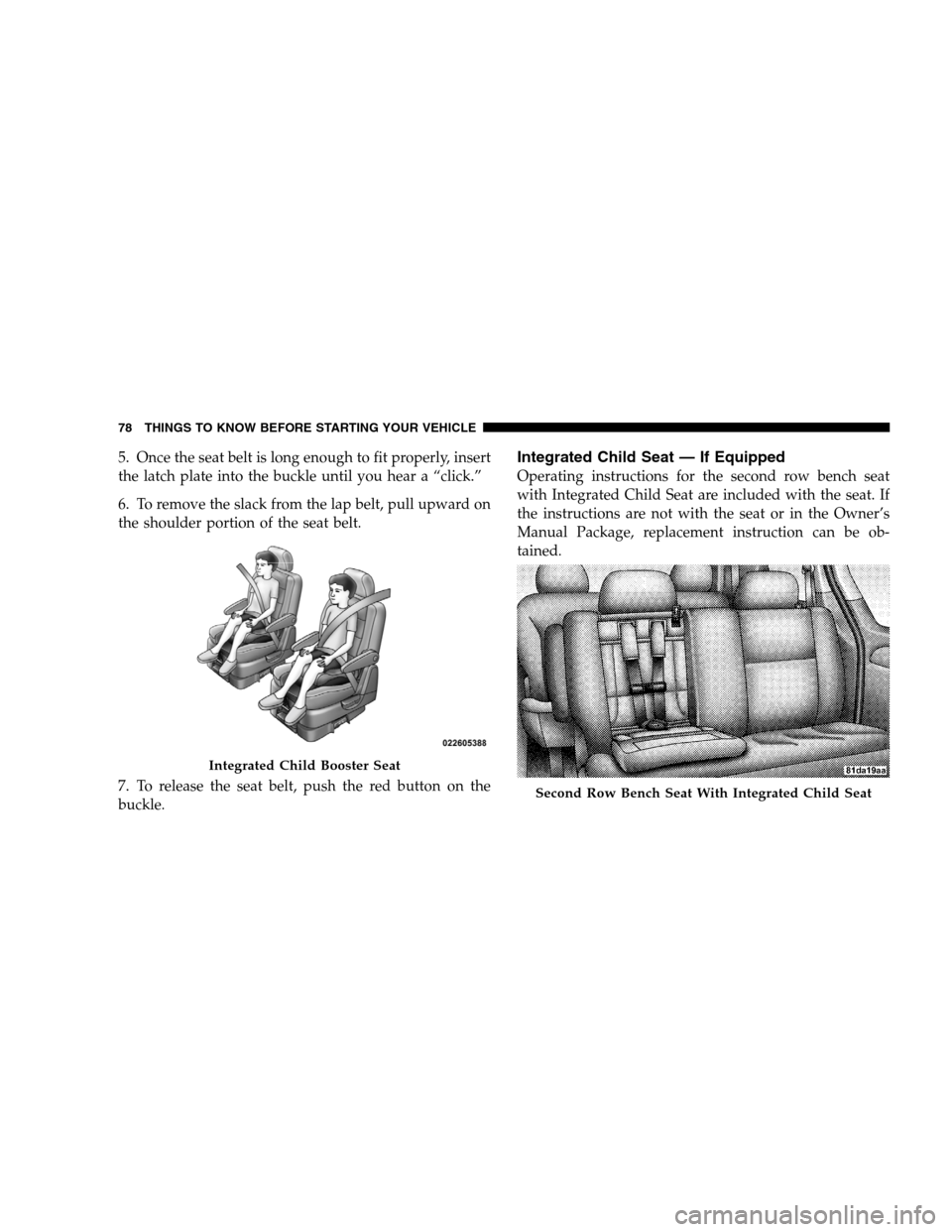
5. Once the seat belt is long enough to fit properly, insert
the latch plate into the buckle until you hear a “click.”
6. To remove the slack from the lap belt, pull upward on
the shoulder portion of the seat belt.
7. To release the seat belt, push the red button on the
buckle.Integrated Child Seat — If Equipped
Operating instructions for the second row bench seat
with Integrated Child Seat are included with the seat. If
the instructions are not with the seat or in the Owner’s
Manual Package, replacement instruction can be ob-
tained.Integrated Child Booster Seat
Second Row Bench Seat With Integrated Child Seat
78 THINGS
TO KNOW BEFORE STARTING YOUR VEHICLE